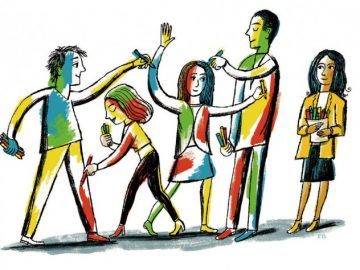Jonathan Shaw in Harvard Magazine:
 WHEN JAL MEHTA and Sarah Fine embarked on a six-year study of 30 of the most effective public high schools in the United States, what they found among students was largely “bored, disengaged compliance,” Mehta recalls. The dominant pattern of instruction is rote transmission: worksheets, multiple-choice questions, and teachers lecturing. Objective comparisons to other countries confirm the mediocrity of this model: U.S. high-school students score near the bottom in math, and are just middling in reading and science. “Not surprisingly,” he says, students consistently called lectures a “very disengaging mode.” But there were bright spots: classrooms where “teachers had moved away from that by dint of their own skill and inventiveness.”
WHEN JAL MEHTA and Sarah Fine embarked on a six-year study of 30 of the most effective public high schools in the United States, what they found among students was largely “bored, disengaged compliance,” Mehta recalls. The dominant pattern of instruction is rote transmission: worksheets, multiple-choice questions, and teachers lecturing. Objective comparisons to other countries confirm the mediocrity of this model: U.S. high-school students score near the bottom in math, and are just middling in reading and science. “Not surprisingly,” he says, students consistently called lectures a “very disengaging mode.” But there were bright spots: classrooms where “teachers had moved away from that by dint of their own skill and inventiveness.”
In every school, the researchers found at least one or two settings where students were engaged and inspired by what they were learning—often in activities outside the classroom. By the end of their study’s first year, Mehta, an associate professor at the Harvard Graduate School of Education, and Fine, who began the project as Mehta’s doctoral student (and is now director of a teacher preparation program associated with a network of schools in San Diego), decided to focus on the bright spots. Their book about the project, In Search of Deeper Learning: The Quest to Remake the American High School (Harvard), weaves analysis and richly descriptive vignettes together in the most comprehensive assessment of the topic since the 1980s.
The authors offer a thoughtful critique of three of the most successful schools, pseudonymously named Dewey High, No Excuses High, and I.B. High. The first, which follows the pedagogical philosophy of John Dewey, LL.D. ’32, is characterized by project-based learning that works because it actively engages students in their own education. No Excuses High is strict, demanding, and goal-oriented.
More here.
